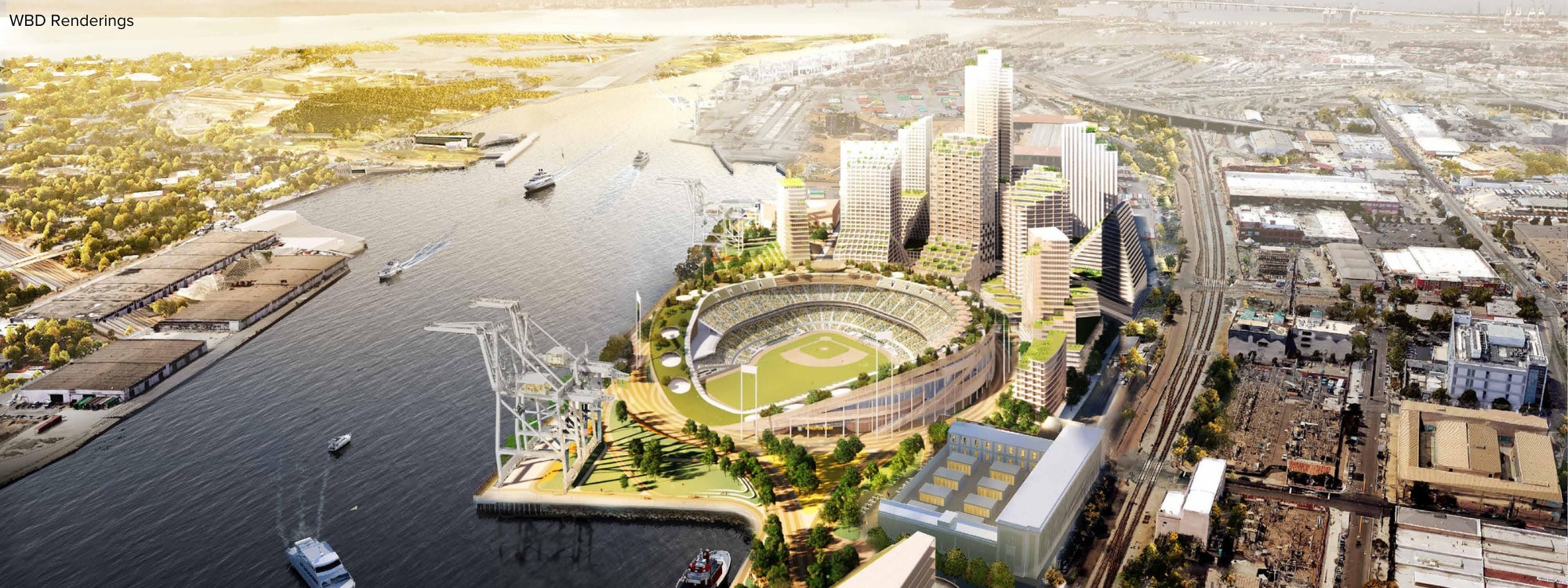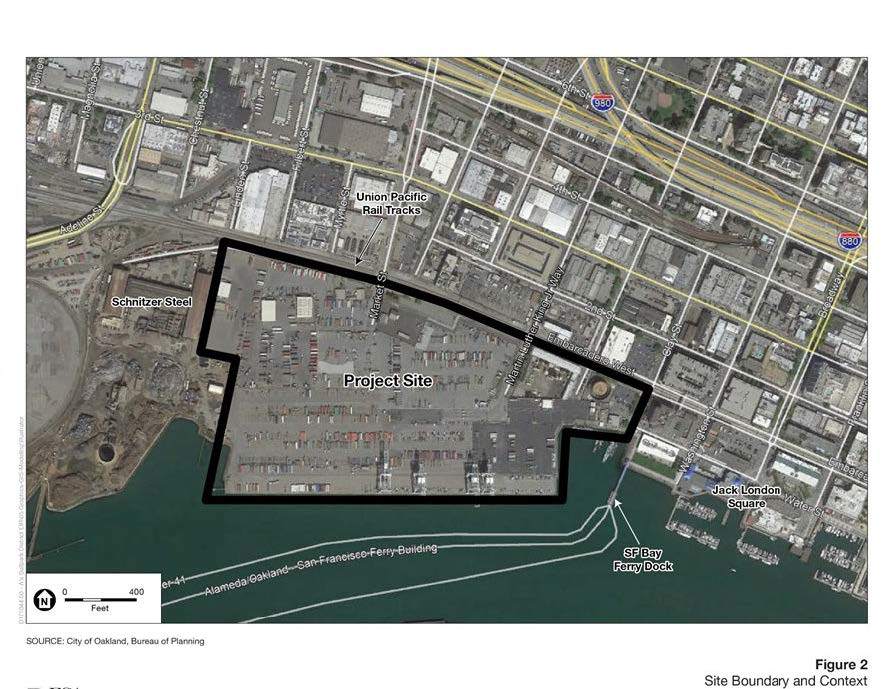After careful review, Greenbelt Alliance is pleased to announce our conceptual endorsement of the Oakland A’s Howard Terminal housing and mixed-use development proposal in Oakland. The Greenbelt Alliance Climate SMART Development Endorsement Program reviews and endorses housing projects within the Bay Area that provide much-needed homes for the region in locations that reduce climate-related impacts and increase resilience.
As such, a critical component in our review is how we can add housing without sprawling out onto wetlands, farmlands, and open spaces. We also look at the proposal’s potential to reduce greenhouse gas emissions through proximity to jobs, services, and transit. Increasing the number of homes in a variety of sizes and affordability levels in prime locations within the inner Bay Area, like Oakland’s Howard Terminal, also means people are less vulnerable to extreme heat and wildfires. Building more homes in areas such as this is one of the most impactful actions we can take at the local level to reduce our climate-related impact and risks.
While the Howard Terminal proposal is most well-known for Oakland A’s ballpark component, the goal of Greenbelt Alliance’s Endorsement Program is to accelerate climate-smart housing. Our endorsements are for and focused on the housing components of any development proposal we review. The Howard Terminal project aims to transform this waterfront area into a vibrant, walkable, mixed-use, cultural and civic center by building 3,000 homes, a hotel, retail, performance venue, and open space in addition to a 35,000-person capacity Major League Baseball park for the Oakland Athletics.
More People, Fewer Emissions
As a large project being developed within an existing community, the proposal plans for various ways to reduce traffic impacts and transportation-related pollution. The waterfront location adjacent to the Oakland Ferry Terminal will provide convenient commute access to San Francisco for residents, with plans for increased ferry access on game days. A transit hub will connect to the three closest BART stations (West Oakland, 12th St, and Lake Merritt), and the plan includes improved pedestrian crossings, protected bike lanes, and widening of sidewalks. Within the actual site, there will be a pedestrian-only promenade creating a special car-free zone around the ballpark.
Developing more homes with access to existing transit systems is crucial to strengthening our transportation network and reducing our region’s greenhouse gas emissions as we continue to grow. This location, with its proximity to multiple BART stations as well as ferry service, will provide many more residents with the opportunity for convenient, car-free living. While not everyone will choose this lifestyle, many people across both age and income spectrums prefer a neighborhood such as this—living close to services, recreational areas, and transit systems. This type of neighborhood is currently underrepresented in the Bay Area, forcing people to live costly, car-dependent lifestyles.
The plan also includes 18 acres of new parks and waterfront open space. With public access on non-event days, this space will serve as a gathering place, strengthening the community—building on the Jack London District and the new Brooklyn Basin community—and continue to reimagine Oakland as a waterfront destination. Success in this area can serve as a model for how the Bay Area and California can continue to grow, increasing housing choices for existing and new residents alike.
Building for Resilience
As we look to build a more climate-resilient region and learn more about climate-related risks, vulnerability to extreme heat is an increasing concern, especially for the elderly and people with underlying health conditions. As part of the Bay Area’s unique geography, our coastal and bay-adjacent region enjoys a year-round temperate climate and a significantly lower risk from extreme heat as compared to the surrounding communities. These parts of our region are also some of the areas that have, in recent decades, adopted some of the most restrictive limits on growth, pushing much more development into areas increasingly subject to extreme heat. The Howard Terminal location sits squarely in the bayfront’s temperate climate zone. When we have the opportunity to build homes and create new neighborhoods for people in places like this, we will mitigate an acute climate-related health risk.
The location is also protected from the risk of wildfires that suburban subdivisions are increasingly facing. However, bayfront locations must of course factor in sea level rise risk. The Howard Terminal project has a plan to raise the site to protect the new development through the turn of the next century. Recent data and projections paint a clearer picture than in the past about what the increases in sea level and groundwater could look like in this area. With this information, we call on the City of Oakland, the Bay Conservation and Development Commission (BCDC), and the Athletic’s development team to work closely together to ensure that this project is a model of adaptive urban shoreline development that will increase protections for new residents and existing development in the surrounding area as well.
An Investment in Inclusive Housing
Howard Terminal is one of a limited number of sites to build a neighborhood-scale development within the existing urban footprint of the city of Oakland. The 3,000 homes will be scattered amongst 100-600 foot highrises to maximize the site’s potential. Projects at this scale are critical to our region’s success to ensure our region’s largest cities do not just become wealthy enclaves for existing residents, and that our region’s farmland and natural areas are not paved over for sprawl development. This project contributes to meeting the City’s ambitious Regional Housing Needs Allocation (RHNA) goals, and will provide new homes at varying levels of affordability, with a plan for 15% onsite affordable and contributions to a fund for permanently affordable homes in other parts of Oakland. Greenbelt Alliance’s endorsement is conceptual at this point because the proposal is not finalized and details such as levels of affordability are being negotiated. We encourage the City and the A’s to maximize levels of affordability and provide a range of unit sizes that will create a truly mixed-income, multi-age community.
Along with the benefits of being close to transit and services, in climate-friendly zones, Howard Terminal also faces challenges related to its location and reuse. The site sits between the existing active mixed-use community in Jack London Square and the Port of Oakland, an important economic engine for the city, the Bay Area, and beyond. Our region’s future rests on our ability to invest in climate-smart development while supporting jobs like those at the Port critical to our economic infrastructure. We call on the leadership of the City of Oakland, the Port of Oakland, and the A’s organization to ensure the investments in Howard Terminal create a new, thriving neighborhood while enhancing the Port’s future success.
What Happens Next
The proposed project’s prime location, multimodal transportation plan, contribution to climate resilience, and commitment to dense housing will enable Oakland to grow smartly and serve as an example of how to prioritize both people and climate change. Greenbelt Alliance believes Howard Terminal will play a pivotal role in reimagining a more resilient and inclusive Oakland for all residents to enjoy. That is why we are proud to give this project our conceptual endorsement! We hope its approval will inspire cities around the Bay Area to double down on their efforts to grow smartly.
The next steps for Howard Terminal include a public hearing on June 2 where the San Francisco Bay Conservation & Development Commission will dive into the proposal’s port designation before making a final decision on June 30.
Greenbelt Alliance’s Climate SMART—Sustainable, Mixed, Affordable, Resilient, Transit-Oriented—Development Endorsement Program goals call for fully protecting the Bay Area’s greenbelt, directing growth into our existing communities, and reducing greenhouse gas emissions in a way that equitably benefits all Bay Area residents. Our Endorsement Program provides support for projects that advance the right kind of development in the right places. By promoting climate SMART development, we can create thriving, resilient neighborhoods with ready access to transit and housing choices for all of the Bay Area’s people.
Find out more about our Endorsement Program here. Feel free to contact our team for more information and support.





